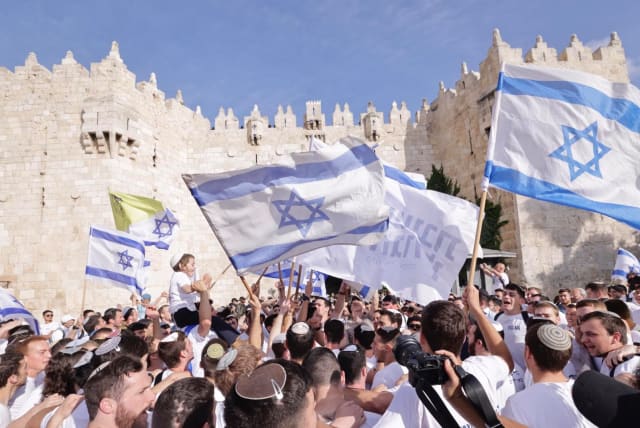Flag march sees river of blue and white celebrations through Jerusalem

After Israeli flags, the most popular were the yellow and white Third Temple Institute flags.
The Jerusalem Flag March began with a mighty stream of people surging down Bezalel Street on Thursday afternoon.
The steady flow of people, mostly clad in blue and white, waved matching Israeli flags.
It seemed as though every school, seminary, yeshiva and youth group had opened their floodgates and poured their children out onto the streets of the capital city. The air was swirling with the bottomless excitement of youth.
A gaggle of girls said it was “wonderful that Israel is ours, and we can celebrate it,” among other rapid-fire comments made at the same time.
Stages with live music were located along the parade route. As the march passed, the street came alive. Waves of young people jumped and bobbed in unison.
“Am Yisrael Chai,” they sang.
The ripples of revelry spread along the length of the street as celebrants danced to the music.
For Hasya, who made aliyah from Toronto almost five years ago, it was her first flag march. She had always wanted to attend, but work had prevented her. This was a happy accident, she said, as she got swept up by the march on her way home.
“It’s so beautiful to see everyone so happy,” Hasya said. “It’s such a wonderful environment; there are just so many young people.”
While the march continued down King George Street, many lingered to enjoy the music. Street vendors and stalls baited the schools of people with overpriced bottles of water and bags of popcorn. The march overflowed into parks, which became momentary harbors of refuge for families with small children who had been agitated by all the noise.
Former Likud MK Yehudah Glick said the holiday was not just about love for Jerusalem, but it was the essence at the heart of the holy city, Zion, and the site of the Temple.
“Our mission is to make Zion a house of prayers of all the nations of the world,” he said.
After Israeli flags, the most popular were the yellow and white Third Temple Institute flags. Some youth groups and yeshivas carried banners and wore shirts depicting the Temples. Also popular were Chabad’s yellow Moshiach flags.
Just over 55 years ago the city was divided
A youth group member from Samaria said it was important to remember on Jerusalem Day that just over 55 years ago the city was divided, and now they could walk through it undivided.
When asked about the security situation, he said terrorist attacks might happen, but the security forces and police were doing their best to prevent them.
All along the march route, the police were positioned. They set up metal levees and blocked off streets with trucks to guide the marchers toward the Old City.
Politicians made speeches on the podiums, with some making explicit calls of support for the Right and judicial reform.
“Why isn’t there a Yemeni judge on the High Court of Justice,” read one man’s sign and T-shirt.
National Security Minister Itamar Ben-Gvir was flanked by security personnel who attempted to part the crowd, but he was mobbed by cheering supporters anyway.
The tone of the parade was jovial, but extremism was present.
A handful of black and yellow Lehava flags stood out against the sea of blue and white. A few Kahanist flags could also be spotted, and at least one man wore a La Familia shirt, associated with the anti-Arab supporters of the Beitar Jerusalem soccer team.
One booth advocated the release of Amiram Ben Uliel, who was convicted for his role in the Duma arson terrorist attack that killed three members of the Dawabsha family, a Palestinian baby and his parents. The booth managers said Ben Uliel had been wrongly convicted after being tortured by the Shin Bet (Israel Security Agency).
Thousands of celebrants rolled up and down the hills and into the Old City.
The good and the bad – these were the people of Israel. But the blue and white drowned out all the other colors.
One woman, Chaya, explained why she attended and was enjoying the march.
“You see the flags, you see the smiles on people, and that’s important,” she said. “It’s the people that make the city.”
Jerusalem Post Store
`; document.getElementById("linkPremium").innerHTML = cont; var divWithLink = document.getElementById("premium-link"); if (divWithLink !== null && divWithLink !== 'undefined') { divWithLink.style.border = "solid 1px #cb0f3e"; divWithLink.style.textAlign = "center"; divWithLink.style.marginBottom = "15px"; divWithLink.style.marginTop = "15px"; divWithLink.style.width = "100%"; divWithLink.style.backgroundColor = "#122952"; divWithLink.style.color = "#ffffff"; divWithLink.style.lineHeight = "1.5"; } } (function (v, i) { });

